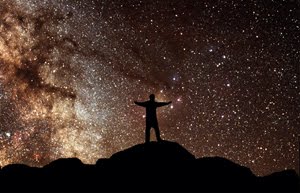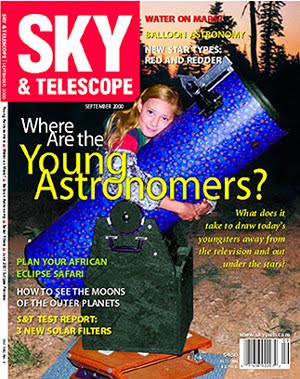A small group was at Willow Springs on Saturday night. Steve Gottlieb, Ray Cash, Charlie Wicks, Darren Hutchison (not sure of your name, sorry) and me. Of course the property owner Bob Ayers was there too, with his other personal guests.
I'm getting accustomed to the drive. Its really only perhaps fourty five minutes more than going to Coe, daPeak, or Dino, which make up the dark three of the "local" south bay observing sites. And the last fourty five minutes are the best... Passing the turnoff to San Juan Bautista and Fremont Peak, the road crosses through fields of vegetatbles and fruit before turning south. A few quick stretces skirting Hollister and you're on highway 25, the scenic route south between highways 5 and 101. Once you pass the golf course, the city slips away and small communities dot the road. Soon you're at Tres Pinos, then after a few more bends Paicines appears. Paicines is a spot, and not much more. Sure, folks live there, make their livings, etc., but its no city. The most remarkable sight are the vineyards and the big winery sitting across the road from the state historical marker for the New Idria Mine. That's where you turn off highway 25, onto little Ponoche Road, and head into the wild country, where the dim galaxies live.
The last 45 mintes drive indeed gets progressively wilder, eventually passing through a section that has a narrow riverbed full of huge boulders, in a deep ravine - it must be a fantastic sight in a heavy storm. The road becomes one lane in places, rough in others, and the last few miles is all twists and turns, but beautiful. The last section on the Willow Springs property is gravel and dirt. It twists up the last 800 feet of elevation to Bob's property. By the end of the drive has you feeling about as far from civilization as you can imagine, for a short drive in a car. Its a great drive.
This trip we set up on the ridge, the high point on Bob's property. Haze lay in the valleys to the south and west. Gunk was obvious in the air to our north and northeast, but we were clear.
By astronomical dark we were observing. It was clear to us the sites to our north and northwest had poor conditions. We had a steady breeze for most of the night that was bothersome, and about two hours of cloudy conditions between about ten and midnight, but the transparency and steadiness were excellent.
We were surprised to not see any Leonids, or let's say, not notice any, but...
Basically, if you wanted to see it in a telescope, you could do it from Willow Springs last night. We observed, listening first to the Cal vs USC game, then the Sharks against Philly...
Here is what I observed, the number of objects surprised me...
Arp 331 - The highlight of this Arp is a chain of eight galaxies running north/south and ranging in magnitude from 12.8 to 14.3 spanning only 15 arcminutes. Well worth a visit, the five brightest visible in Ray's 13.1". I observed 15 members mostly at 293X - N382, N383, N380, N379, N386, N375, N384, N385, N388, I1618, CGCG501-77, N399, N403, N374, UCG692.
Arp 229 - A beautiful and ghostly arc of five galaxies curve ten arcminutes around a mag 7.1 and 10.7 double star, reminiscent of Hickson 68. But there are many other dim galaxies in the area. The close pair NGC507 and 508 dominate the main group. Again, a very worthwhile group. I observed 16 members - N507, N508, N504, N494, N503, I1689, I1682, I1680, CGCG502-43, N483, N501, N499, N495, N496, N515, N517.
AGC 119 - This Abell Galaxy Cluster covered about one degree of sky and in which I observed 14 galaxies. This can be a difficult group, with only two members in the center brighter than mag 15. Yet, the way they are aligned, like other clusters I'd seen during the night, made me feel these objects were playing follow the leader in some way.... stretched out in a line. Still, I teased out UGC579, UGC583, GCGC384-37, CGCG384-40, CGCG384-42, CGCG384-36, CGCG384-32, CGCG384-35, UGC587, UGC595, CGCG384-28, CGCG384-29, UGC568, UGC570.
AGC 194 - Speaking of galaxy chains, Abell Galaxy Cluster 194 is quite a show, having over fifteen galaxies in a stream north-northwest to south-southeast. Check this chain out in a DSS image. The three brightest members are NGC 541/545/547, within a space of six arcminutes. Here are the seventeen members I found - N543, CGCG385-129, N545, N547, N541, N535, UGC1003, UGC996, UGC984, UGC538,UGC974, N530, I11696, N519, CGCG385-112, CGCG385-102, CGCG385-100
From the Miles Paul Atlas of Galaxy Trios I found N1228, N1229, N1230.
From Adventures in Deep Space Favorites I was surprised at the size and knottiness of the face on spiral galaxy NGC 1232 in Eridanus.
Hickson 34 is such a small tight group, I was surprised. I could pick out two, perhaps 3 components. I'd like to try this grou on a still night with excellent seeing.
Abell 10 - this was a bright planetary (in comparison to others I've hunted).
Abell 12 - Steve told me to use high power and an OIII filter. This planetary is otherwise overwhelmed in the glare of a mag 4.1 star Mu Orionis. The planetary, at 293X, is a large bulge in the glare of the bright star, and quite obvious.
Howell-Crisp 1 - Ray Cash was the first of our group to tackle this object, recently discovered by Richard Crisp and an associate in Texas. It is very dim. Steve said he'd classify it as being as tough as the 20 most difficult Abell planetaries. But, it was there, and showed up best using a DGM Optics NPB filter. I found it most visible with a 12 Nagler (in my 18" f/4.5), while Steve and Ray thought lower power, with a 20 Nagler, was better. The object is a faint haze with occasional sharp edge on its SW perimeter. Mostly round, but perhaps if there is elongation, there is not much.
IC 443 - This supernova remnant in Gemini is close to Howell-Crisp 1. At the eyepiece, its shape closely resembles the isophote in Megastar. Not a difficult object.
IC 444 - this may be an emission nebula, it seems very low surface brightness. I felt there were just hints of nebulosity throughout the area.
I could have gone on, but the breeze was bothersome, and the problems with my computer that I've had over the year continued, and out it went. It runs fine at home - I've been writing this report on it. So I poked around at a few pieces of eye candy - NGC 2903 in Leo. The NGC 3190 group, also in Leo. M42. Everything around there was awesome - if you can imagine teasing out dim galaxies all night, then having a knock-your-eye view of M42. The Running Man - NGC 1977 was so full of nebulosity - without any filter - it looked to me like good photos of the Merope Nebula. I was stunned at the seeing and transparency on the bright targets!
Finally, around 3 a.m. or so, I had it. I thought for a last object I'd try for Leo 1. So I swung the scope toward Regulus, and, looking in the eyepiece was surprised to see the bright star had - a ring? I'd mistaken nearby Saturn for Regulus. Saturn was an even better finish. Willow Springs steady seeing was really showing it off - on a non-breezy night, the planet would have been tranfixing.
Oh... last fun bit of info about the night... we were visited by one of Bob's neighbors, maybe around midnight... he asked what we were looking at. Turns out he's an amateur astronomer too. Lives down the hill a bit. Owns two Dobs. A 17", and a 33" f/5. OMG!
As for Willow Springs - it pays to get out into the wilds. Looking forward to December! Thanks again to Bob Ayers for inviting us.
Gobble gobble!











